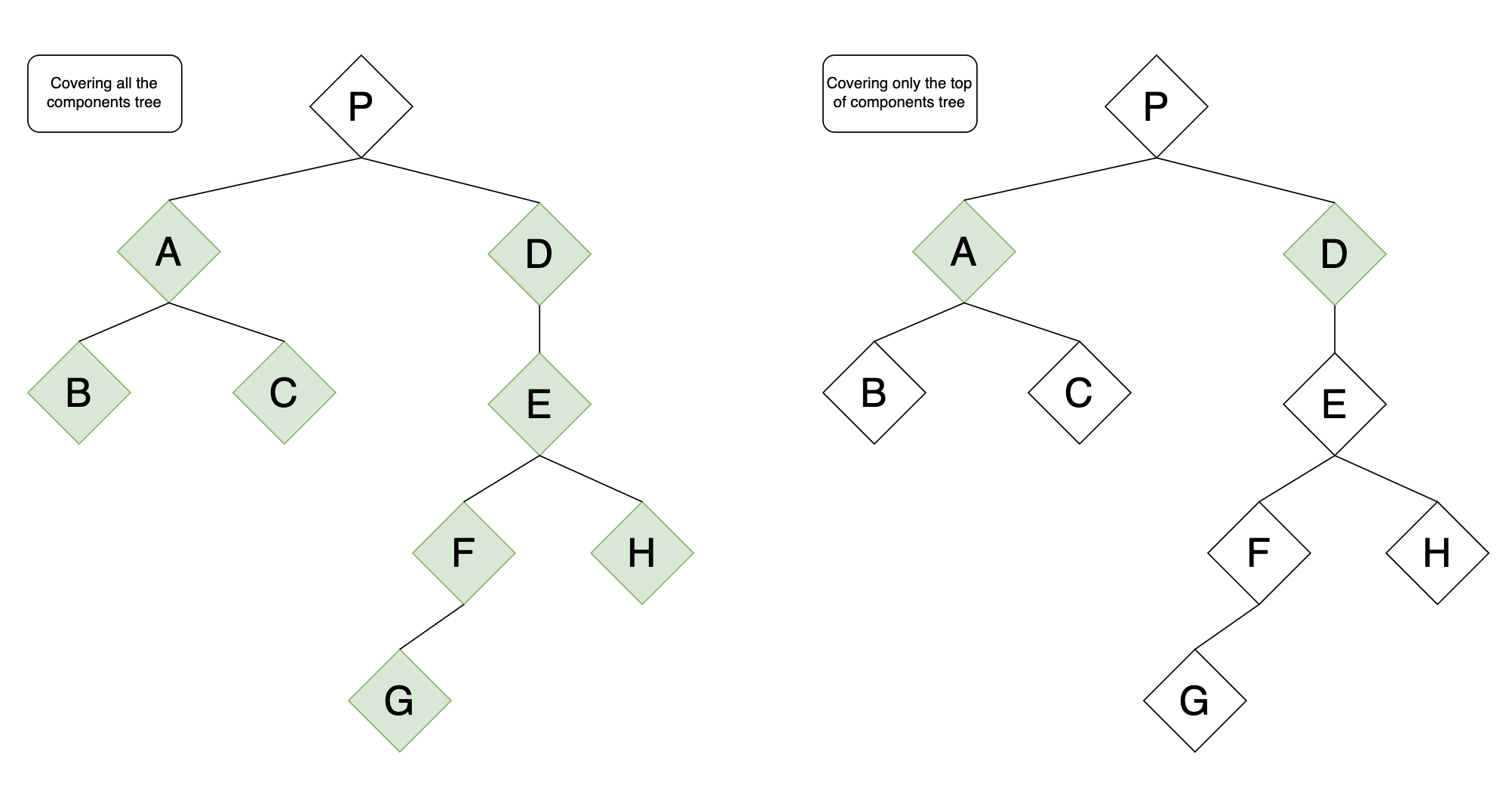Integration Testing Coverage
Do you need to cover ALL the components with integration tests? Let's visualize the test coverage for both variants:

As we know, shallow rendering is a bad idea. So we are going to write the full tests suit for our component. Let’s start our testing step by step.
Covering all the components
- Writing the tests for components
B and C. - Writing the tests for component
A. But wait … I want to cover all the scenarios. Okay, componentAis built usingB and Cones, so I could just copy the test suits from them and paste them inside theAcomponent tests.
The same situation with component D. The F component includes the G one. The E component includes the F and H ones. And, finally, the D component includes the E one.
Nice, all the components tree is covered with tests. So what do we have for now?
- We have spent much time covering the components tree with tests as the tests grow exponentially up to the top of the tree.
- If we add or remove some functionality to component
G, we should add the test cases to theF, E, and Dcomponents, as all of them got the additional functionality or some functionality was removed. - All the components have strong documentation in the code - our test cases are our documentation, so the code review and onboarding are easier.
- If there is a bug inside component
G, the tests for componentsF, E, and Dwill fail - so we know that all of them have incorrect behavior. What is important, we could easily detect the root cause - componentG, as its tests failed too.
Covering only the Top-Level components
- Writing the tests for components
A and D, cover all the scenarios, including the child component's behavior.
Thats all. What do we have in this variant? Actually, we have direct opposition.
- We have spent time covering only the top-level components and obviously, it was faster.
- If add or remove some functionality to the lower-level components, we just need to adjust test cases inside the
A and Dtests. - Only the top-level components are documented.
- If there is a bug inside component
G, the tests for componentsA and Dwill fail - but we could not easily find the root cause, so the time for debugging will be increased.
Pros and Cons
| Cons | Pros |
|---|---|
| The tests grow exponentially. | It is easier to find a component where the bug is present - high confidence. |
| It is more difficult to keep all the tests up to date. More time for refactoring the components is needed. | Strong documentation in the code, so the code review and onboarding are easier. |
What do the “Top-Level components” mean?
The answer depends. I could just recommend the following variants:
The components that are exported from some module.
Each project has its module structure. Let’s analyze one of them, based on the Atomic Design methodology:
src/components
atoms
Button
Field
Image
MultiSelect
components
SelectItem
SelectSubItem
molecules
ButtonsGroup
Snackbar
components
CloseButton
SeverityIcon
organisms
Form
components
FormSection
SubmitButton
In this case, the TopLevel components would be the next ones:
- Atoms: Button, Field, Image, MultiSelect
- Molecules: ButtonsGroup, Snackbar
- Organisms: Form
So for integration tests, the coverage of these components would be enough. I don’t need to cover the SelectItem, SelectSubItem components as they would be tests together with the whole MultiSelect one. The same situation with Snackbar and Form components.
Conclusion
So what way to choose? In my opinion, ALL the components should be covered with integration tests (100% test coverage) in the:
- open source libraries and projects - most open source projects are small libraries and tools that are reusable in many different situations. So a breakage could lead to a serious problem in a lot of consuming projects. And they're relatively easy to get 100% code coverage on anyway.
- pet projects - it is a good way to fall in love with tests and to understand all the pros and cons of 100% test coverage.
For commercial products, it is enough to cover all the TopLevel cmps with integration tests.
By the way, everyone should always keep in mind WHY you cover your components with integration tests - Write tests. Not too many. Mostly integration.